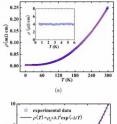Scientists enhance synthesis of chromium dioxide (100) epitaxial thin film growth
Related images
(click to enlarge)
Half-metallic ferromagnet CrO2 has attracted much attention not only because of its fundamental physics related with high spin polarization but also because of its possible applications in the emerging area of spintronics. In these applications, synthesis of CrO2 films is of fundamental importance, primarily because of the difficulty in its synthesis, as it is not known to form under ambient pressures in a pure form. Extensive efforts have been made to grow high quality CrO2 films, but the growth technology still deserves research.
The high quality CrO2 film on the (100)-oriented TiO2 substrate has been successfully fabricated using a simple route under ambient pressures in a pure form and the transport properties and the magnetic properties were also studied.
The high quality of the sample is indicated by the XRD patterns with the narrow width of 0.38o in the rocking curve of the (200) peak. The temperature dependence of resistivity can be fitted with ρ(T)=ρ0+AT2exp(-△/T) over the range of 0.6-300 K. The in-plane magnetic measurements show that the magnetization of the film becomes saturated in a relatively low field with a small coercive field. The temperature dependence of the magnetization follows Bloch's T3/2 law and the slope suggests a critical wavelength of λ△ ~ 26.6 Å beyond which spin-flip scattering becomes important.
Source: World Scientific
Other sources
- Scientists enhance synthesis of chromium dioxide (100) epitaxial thin film growthfrom Science DailySat, 9 Aug 2014, 20:30:38 UTC
- Scientists enhance synthesis of chromium dioxide (100) epitaxial thin film growthfrom PhysorgFri, 8 Aug 2014, 14:01:00 UTC
